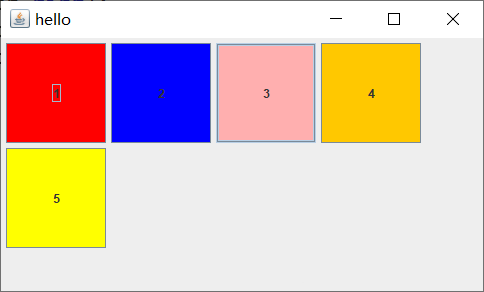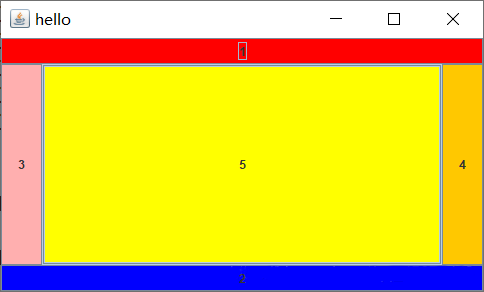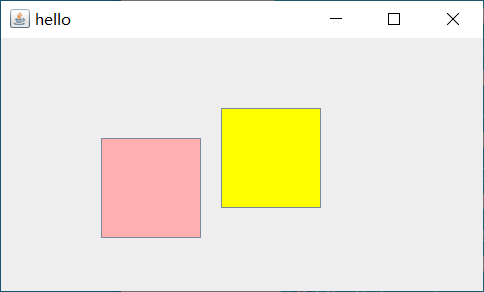流式布局
采用流式布局会将元素按从左到右的顺序排列,如果一个元素在一行中放不下,那这个元素会另起一行依然按照从左到右的顺序排列
示例:

代码
public class Test {
public static void main(String[] args) {
// 创建窗口
JFrame jFrame = new JFrame();
// 设置窗口名称
jFrame.setTitle("hello");
// 创建流式布局管理器 对齐方式为左对齐
LayoutManager layout = new FlowLayout(FlowLayout.LEFT);
// 关闭窗口结束程序
jFrame.setDefaultCloseOperation(JFrame.EXIT_ON_CLOSE);
// 创建内容面板
Container contentpage = jFrame.getContentPane();
// 设置内容面板布局方式为流布局
contentpage.setLayout(layout);
// 创建按钮
JButton button1 = new JButton("1");
JButton button2 = new JButton("2");
JButton button3 = new JButton("3");
JButton button4 = new JButton("4");
JButton button5 = new JButton("5");
// 设置按钮大小
button1.setPreferredSize(new Dimension(100,100));
button2.setPreferredSize(new Dimension(100,100));
button3.setPreferredSize(new Dimension(100,100));
button4.setPreferredSize(new Dimension(100,100));
button5.setPreferredSize(new Dimension(100,100));
// 设置按钮背景颜色
button1.setBackground(Color.red);
button2.setBackground(Color.blue);
button3.setBackground(Color.pink);
button4.setBackground(Color.orange);
button5.setBackground(Color.yellow);
// 将按钮添加到内容面板中
contentpage.add(button1);
contentpage.add(button2);
contentpage.add(button3);
contentpage.add(button4);
contentpage.add(button5);
// 设置窗口大小
jFrame.setSize(500, 300);
// 设置窗口可见
jFrame.setVisible(true);
}
}
边界布局
采用边界布局会将元素分别划分到东,西,中,南,北五个方位,分别使用EAST,WEST,CENTER,SOUTH,NORTH标识,每个方位只能放一个元素
示例

代码
public class Test {
public static void main(String[] args) {
// 创建窗口
JFrame jFrame = new JFrame();
// 设置窗口名称
jFrame.setTitle("hello");
// 创建边界布局管理器
BorderLayout layout = new BorderLayout();
// 关闭窗口结束程序
jFrame.setDefaultCloseOperation(JFrame.EXIT_ON_CLOSE);
// 创建内容面板
Container contentpage = jFrame.getContentPane();
// 设置内容面板布局方式为流布局
contentpage.setLayout(layout);
// 创建按钮
JButton button1 = new JButton("1");
JButton button2 = new JButton("2");
JButton button3 = new JButton("3");
JButton button4 = new JButton("4");
JButton button5 = new JButton("5");
// 设置按钮背景颜色
button1.setBackground(Color.red);
button2.setBackground(Color.blue);
button3.setBackground(Color.pink);
button4.setBackground(Color.orange);
button5.setBackground(Color.yellow);
// 将按钮添加到内容面板中
// 将按钮放置到北部
contentpage.add(button1,BorderLayout.NORTH);
// 将按钮放置到南部
contentpage.add(button2,BorderLayout.SOUTH);
// 将按钮放置到西部
contentpage.add(button3,BorderLayout.WEST);
// 将按钮放置到东部
contentpage.add(button4,BorderLayout.EAST);
// 将按钮放置到中心
contentpage.add(button5,BorderLayout.CENTER);
// 设置窗口大小
jFrame.setSize(500, 300);
// 设置窗口可见
jFrame.setVisible(true);
}
}
卡片布局
顾名思义,若一个容器使用卡片布局,其里面的所有组件就像是一副牌一样重叠在一起,容器只能显示一个组件,默认显示第一个组件,可以通过CardLayout中的show方法改变显示的组件
示例
显示第一个按钮

显示第二个按钮

代码
public class Test {
public static void main(String[] args) {
// 创建窗口
JFrame jFrame = new JFrame();
// 设置窗口名称
jFrame.setTitle("hello");
// 创建卡片布局管理器
CardLayout layout = new CardLayout();
// 关闭窗口结束程序
jFrame.setDefaultCloseOperation(JFrame.EXIT_ON_CLOSE);
// 创建面板
JPanel jPanel = new JPanel();
// 设置面板布局方式为卡片布局
jPanel.setLayout(layout);
// 添加 按钮 设置背景颜色
JButton jButton1 = new JButton();
jButton1.setBackground(Color.pink);
JButton jButton2 = new JButton();
jButton2.setBackground(Color.yellow);
// 将按钮添加到面板中并对按钮进行命名
jPanel.add(jButton1,"bt1");
jPanel.add(jButton2,"bt2");
// 指定在面板上显示的按钮
layout.show(jPanel, "bt2");
// 将面板添加到窗口中
jFrame.add(jPanel);
// 设置窗口大小
jFrame.setSize(500,300);
// 设置窗口可见
jFrame.setVisible(true);
}
}
自定义布局
所谓自定义布局就是不使用任何布局管理器,而是我们自己通过指定组件的X坐标,Y坐标,宽度,高度来指定组件的位置
这里的坐标和我们平时的坐标有些区别,如下:

组件是以左上角顶点为原点来定位坐标,使用自定义布局,要将容器使用的布局管理器设置为null
那有的小伙伴会问了,既然布局管理器设置为null,那可不可以直接不设置啊,当然不行,如果不设置的话,组件会不显示
示例

代码
public class Test {
public static void main(String[] args) {
// 创建窗口
JFrame jFrame = new JFrame();
// 设置窗口名称
jFrame.setTitle("hello");
// 关闭窗口同时结束程序
jFrame.setDefaultCloseOperation(JFrame.EXIT_ON_CLOSE);
// 创建面板
JPanel jPanel = new JPanel();
// 使用自定义布局,将容器使用的布局管理器设置为null
jPanel.setLayout(null);
// 添加 按钮 设置背景颜色
JButton jButton1 = new JButton();
jButton1.setBackground(Color.pink);
JButton jButton2 = new JButton();
jButton2.setBackground(Color.yellow);
// 设置按钮的坐标为(100,100) ,宽度为100,高度为100
jButton1.setBounds(new Rectangle(100,100,100,100));
// 设置按钮的坐标为(220,70) ,宽度为100,高度为100
jButton2.setBounds(new Rectangle(220,70,100,100));
// 将按钮添加到面板中
jPanel.add(jButton1);
jPanel.add(jButton2);
// 将面板添加到窗口中
jFrame.add(jPanel);
// 设置窗口大小
jFrame.setSize(500,300);
// 设置窗口可见
jFrame.setVisible(true);
}
}
到此本篇关于Java图形界面的几种常用布局方式及常用布局方式的额使用方法的文章就介绍到这了,想要了解更多相关Java 图形界面布局其他的内容请搜索W3Cschool以前的文章或继续浏览下面的相关文章,也希望大家以后多多支持!

 免费 AI IDE
免费 AI IDE



